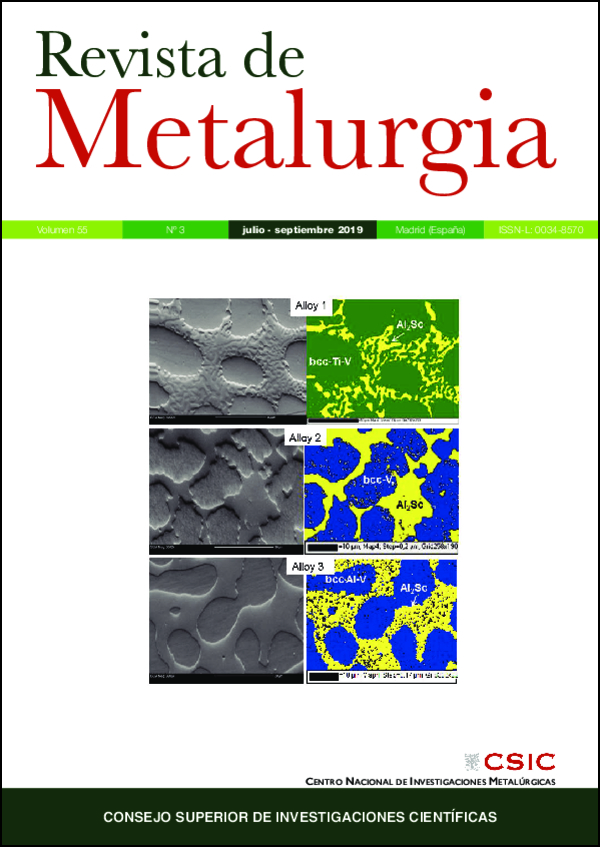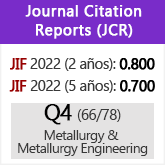La eliminación de metales tóxicos presentes en efluentes líquidos mediante resinas de cambio iónico. Parte IX: Antimonio(III))/H+/Ionac SR7
DOI:
https://doi.org/10.3989/revmetalm.152Palabras clave:
Antimonio(III), Efluentes líquidos, Eliminación, Ionac SR7, Nanotubos de carbono de pared múltipleResumen
Este trabajo presenta los resultados obtenidos en el estudio de la eliminación de Sb(III) de disoluciones acuosas acidas utilizando la resina de cambio iónico Ionac SR7. En el estudio se consideran diferentes variables experimentales: la velocidad de agitación (280–1000 min-1), la temperatura (20–60 °C), la concentración de ácido en la disolución acuosa (0,1–2 M HCl), la concentración de resina (2,5–20 g·L-1), y el tipo de sal empleado en los ensayos a fuerza iónica constante. La carga de Sb(III) en la resina responde a una reacción de intercambio aniónico, siendo esta exotérmica y espontánea. Los resultados experimentales se han utilizado para estimar el modelo cinético, el modelo y la isoterma de carga del metal en al resina, encontrándose que estos responde a un modelo cinético de pseudo-segundo orden, a un modelo de difusión en partícula y a la isoterma de Freundlich, respectivamente. Los resultados obtenidos en la resina Ionac SR7 se han comparado con los obtenidos con otras resinas de intercambio aniónico y con nanotubos de carbono de pared múltiple. El antimonio cargado en al resina se puede eluir de forma efectiva usando agua como eluyente.
Descargas
Citas
Alguacil, F.J., Coedo, A.G., Dorado, T., Padilla, I. (2002). The removal of toxic metals from liquid effluents by ion exchange resins. Part I: chromium(VI)/sulphate/Dowex 1x8. Rev. Metal. 38 (4), 306-311. https://doi.org/10.3989/revmetalm.2002.v38.i4.412
Alguacil, F.J. (2002). The removal of toxic metals from liquid effluents by ion exchange resins. Part II: cadmium(II)/sulphate/Lewatit TP260. Rev. Metal. 38 (5), 348-352. https://doi.org/10.3989/revmetalm.2002.v38.i5.418
Alguacil, F.J. (2003). The removal of toxic metals from liquid effluents by ion exchange resins. Part III: copper(II)/sulphate/Amberlite 200. Rev. Metal. 39 (3), 205-209. https://doi.org/10.3989/revmetalm.2003.v39.i3.330
Alguacil, F.J., López, F.A., Rodriguez, O., Martinez-Ramirez, S., Garcia-Díaz, I. (2016). Sorption of indium (III) onto carbon nanotubes. Ecotox. Environ. Safe. 130, 81-86. https://doi.org/10.1016/j.ecoenv.2016.04.008 PMid:27085001
Alguacil, F.J. (2017a). The removal of toxic metals from liquid effluents by ion exchange resins. Part IV: chromium(III)/H+/Lewatit SP112. Rev. Metal. 53 (2), e093.
Alguacil, F.J. (2017b). The removal of toxic metals from liquid effluents by ion exchange resins. Part V: nickel(II)/H+/Dowex C400. Rev. Metal. 53 (4) e105.
Alguacil, F.J. (2018a). The removal of toxic metals from liquid effluents by ion exchange resins. Part VI: manganese(II)/H+/Lewatit K2621. Rev. Metal. 54 (2), e116.
Alguacil, F.J. (2018b). The removal of toxic metals from liquid effluents by ion exchange resins. Part VII: manganese(VII)/H+/Amberlite 958. Rev. Metal. 54 (3), e125.
Alguacil, F.J. (2018c). The removal of toxic metals from liquid effluents by ion exchange resins. Part IX: lead(II)/H+/Amberlite IR120. Rev. Metal. 55 (1), e138.
Alguacil, F.J., Escudero, E. (2018). The removal of toxic metals from liquid effluents by ion exchange resins. Part VIII: arsenic(III)/OH?/Dowex 1x8. Rev. Metal. 54 (4), e132.
ATSDR (2017). Toxicological profile for antimony compounds. Agency for Toxic Substances and Disease Registry, USA. Checked June 2019: https://www.atsdr.cdc.gov/toxprofiles/tp23.pdf.
Constantino, L.V., Quirino, J.N., Abrão, T., Parreira, P.S., Urbano, A., Santos, M.J. (2018). Sorption-desorption of antimony species onto calcined hydrotalcite: Surface structure and control of competitive anions. J. Hazard. Mater. 344, 649-656 https://doi.org/10.1016/j.jhazmat.2017.11.016 PMid:29149765
Deng, R.-J., Jin, C.-S., Ren, B.-Z., Hou, B.-L., Hursthouse, A.S. (2017). The potential for the treatment of antimony-containing wastewater by iron-based adsorbents. Water-Sui 9 (10), article number 794. https://doi.org/10.3390/w9100794
Dupont, D., Binnemans, K. (2016). Antimony recovery from the halophosphate fraction in lamp phosphor waste: a zero-waste approach. Green Chem. 18, 176-185. https://doi.org/10.1039/C5GC01746G
López Diaz-Pavón, A., Cerpa, A., Alguacil, F.J. (2014). Processing of indium(III) solutions via ion exchange with Lewatit K-2621 resin. Rev. Metal. 50 (2), e010. https://doi.org/10.3989/revmetalm.010.
Mitrakas, M., Mantha, Z., Tzollas, N., Stylianou, S., Katsoyiannis, I., Zouboulis, A. (2018). Removal of antimony species, Sb(III)/Sb(V), from water by using iron coagulants. Water-Sui. 10 (10), article number 1328. https://doi.org/10.3390/w10101328
Multani, R.S., Feldmann, T., Demopoulos, G.P. (2016). Antimony in the metallurgical industry: A review of its chemistry and environmental stabilization options. Hydrometallurgy 164, 141-153. https://doi.org/10.1016/j.hydromet.2016.06.014
Naghizadeh, A., Kamranifar, M., Yari, A.R., Mohammadi, M.H. (2017). Equilibrium and kinetics study of reactive dyes removal from aqueous solutions by bentonite nanoparticles. Desalin. Water Treat. 97, 329-337. https://doi.org/10.5004/dwt.2017.21687
Qi, P., Pichler, T. (2016). Sequential and simultaneous adsorption of Sb(III) and Sb(V) on ferrihydrite: Implications for oxidation and competition. Chemosphere 45, 55-60. https://doi.org/10.1016/j.chemosphere.2015.11.057 PMid:26688239
Sari, A., Tuzen, M., Kocal, ?. (2017). Application of chitosan-modified pumice for antimony adsorption from aqueous solution. Environ. Prog. Sustain. 36 (6), 1587-1596. https://doi.org/10.1002/ep.12611
Ungureanu, G., Santos, S., Boaventura, R., Botelho, C. (2015). Arsenic and antimony in water and wastewater: Overview of removal techniques with special reference to latest advances in adsorption. J. Environ. Manage. 151, 326-342. https://doi.org/10.1016/j.jenvman.2014.12.051 PMid:25585146
USEPA (2011). Designation of hazardous substances. Subchapter D-water programs. Code for federal regulations. United States Environmental Protection Agency, USEPA 40 CFR 116. https://www.govinfo.gov/app/details/CFR-2011-title40-vol22/CFR-2011-title40-vol22-part116.
Wang, R., Li, G., Yang, Y., Shu, L., Jegatheesan, V., Wang, H., Yang, M. (2017). Study of the adsorption performance for fluoride by mesoporous silica loaded rare earth lanthanum (Ms-La) material. Desalin. Water Treat. 96, 104-111. https://doi.org/10.5004/dwt.2017.21473
WHO (2011). Guidelines for drinking-water quality. World Health Organization. http://whqlibdoc.who.int/publications/2011/9789241548151_eng.pdf?ua=1.
Yang, K., Zhou, J., Lv, D., Sun, Y., Lou, Z., Xu, X. (2017). Preparation and Application of Iron-Based Composite Materials for the Removal of Antimony from Aqueous Solution. Progr. Chem. 29 (11), 1407-1421.
Zhu, Y., Wu, M., Gao, N., Chu, W., An, N., Wang, Q., Wang, S. (2018). Removal of antimonate from wastewater by dissimilatory bacterial reduction: Role of the coexisting sulfate. J. Hazard. Mater. 341, 36-45. https://doi.org/10.1016/j.jhazmat.2017.07.042
Publicado
Cómo citar
Número
Sección
Licencia
Derechos de autor 2019 Consejo Superior de Investigaciones Científicas (CSIC)

Esta obra está bajo una licencia internacional Creative Commons Atribución 4.0.
© CSIC. Los originales publicados en las ediciones impresa y electrónica de esta Revista son propiedad del Consejo Superior de Investigaciones Científicas, siendo necesario citar la procedencia en cualquier reproducción parcial o total.Salvo indicación contraria, todos los contenidos de la edición electrónica se distribuyen bajo una licencia de uso y distribución “Creative Commons Reconocimiento 4.0 Internacional ” (CC BY 4.0). Puede consultar desde aquí la versión informativa y el texto legal de la licencia. Esta circunstancia ha de hacerse constar expresamente de esta forma cuando sea necesario.
No se autoriza el depósito en repositorios, páginas web personales o similares de cualquier otra versión distinta a la publicada por el editor.


















